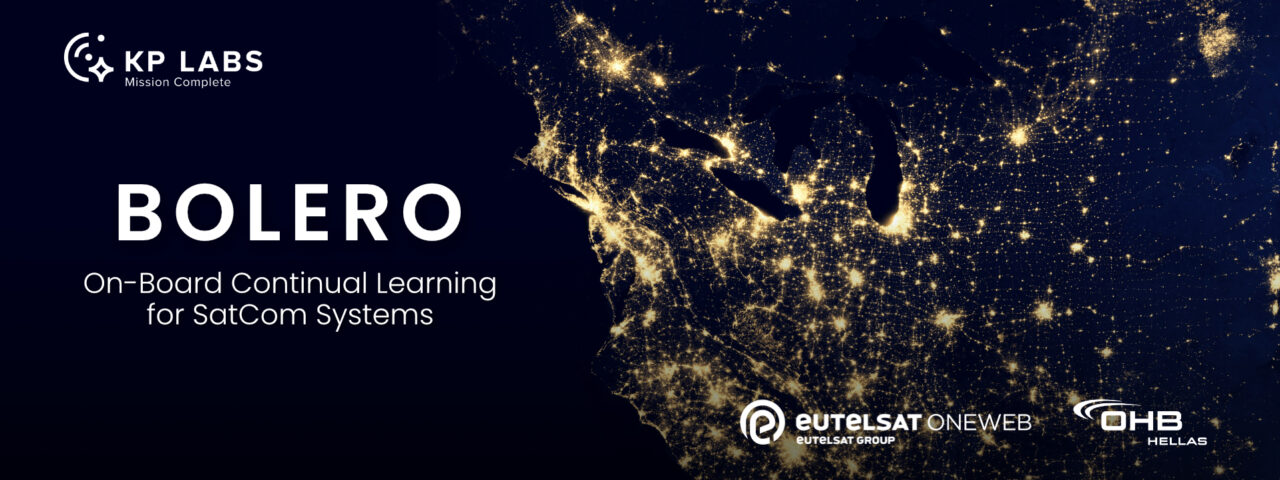OHB Hellas are not only exploring Akida for their ‘Satellite as a Service’ concept (GIASAAS)

, but also as a consortium partner for an ESA project called
BOLERO (On-Board Continual Learning for SatCom Systems).
Prime contractor of the BOLERO project is KPLabs - both OHB Hellas and Eutelsat OneWeb are subcontractors.
View attachment 83668
Our mission is to connect Europe. We join engineers, entrepreneurs and investors to forge strong links between institutions, industries, and businesses.

connectivity.esa.int
BOLERO On-Board Continual Learning For SatCom Systems
Objectives
The project identifies, explores, and implements onboard continual machine learning techniques to enhance reliability and data throughput of communication satellites.
The first objective is to identify 3 most promising use cases and applications of continual learning (CL), together with at least two most promising hardware platforms.
The second objective is to implement different CL techniques in the selected scenarios and assess their performance and feasibility for onboard deployment using the selected hardware platforms. The assessment includes the analysis of advantages and trade-offs of CL in comparison to traditional offline machine learning approaches, and the comparative analysis of hardware platforms for CL.
The final goal of the project is to identify a state-of-the-art, potential gaps, and future roadmap for CL in satellite communication systems.
Challenges
The main challenge is related to the limited resources and limited support for continual machine learning mechanisms in existing onboard processing units, e.g., not all operations and layers are supported and model parameters cannot be updated without hardware-specific recompilation. Therefore, common CL approaches are not straightforward to implement on board. Additionally, CL techniques come with the stability-plasticity trade-offs and the need of continuous validation and monitoring.
Benefits
The project offers a complete software and hardware pipeline to implement 3 different continual machine learning approaches (i.e., class-incremental, domain-incremental, and task-incremental) in 3 different application for communication satellites. The comparative analysis helps to identify which approach and hardware platform is best suited for different CL scenarios. The project establishes the foundation for future development of CL in SatCom systems.
Features
- Structured and informed report from selecting 3 most promising applications of CL in communication satellites and 2 hardware platforms
- Code for running a complete onboard CL process for both hardware platforms
- Report containing technology gaps and future roadmap for CL in SatCom systems
System Architecture
The 3 CL applications identified in the project are implemented for two hardware platforms of very different architectures (KP Labs Leopard DPU and BrainChip Akida neuromorphic computer). For each application and platform, there is a complete CL pipeline architecture proposed from data preprocessing to onboard continual learning.
Current status
The 3 most promising applications of continual machine learning in communication satellites have been identified, i.e., domain-incremental beam hopping optimization, task-incremental inter-satellite links routing, and class-incremental telemetry anomaly classification.
For each application, a state-of-the-art CL approach has been implemented for two diverse hardware platforms identified as the most promising ones for CL (KP Labs Leopard DPU and BrainChip Akida neuromorphic computer). The performance of each CL approach has been assessed and main technology gaps have been identified.
documentation
Documentation may be requested
Prime Contractor

Poland
https://kplabs.space
Subcontractors

Greece
Website

United Kingdom
https://oneweb.net/
Last update
2025-05-03 12:39
Discover insights from KP Labs in our news update, BOLERO: On-Board Continual Learning for SatCom Systems, focusing on key developments and innovations in satellite systems and space exploration.

www.kplabs.space
PROJECT
4 min read
BOLERO: On-Board Continual Learning for SatCom Systems
Published on
January 28, 2025
In an era of exponentially increasing data generation across all domains, satellite communications (SatCom) systems are no exception. The innovative
BOLERO project, led by KP Labs, and supported by a consortium including
OHB Hellas and Eutelsat OneWeb, is at the forefront of this technological evolution. This project is making significant strides in applying both
classic and deep machine learning (ML and DL) techniques within the dynamic realm of satellite data, marking a transformative step in SatCom technology.
Understanding the Need for Continual Learning in SatCom
Traditionally, satellite applications have relied on supervised ML algorithms trained offline, with all training data prepared before the training process begins. This method is effective in stable data scenarios. For example, a deep learning model can accurately identify brain tumor lesions from magnetic resonance images after being trained on a diverse dataset. However, the dynamic space environment presents unique challenges. Factors such as thermal noise, atmospheric conditions, and on-board noise can significantly alter data characteristics, causing these offline-trained models to struggle or fail when encounteringnew, unfamiliar data distributions.
The BOLERO Approach
BOLERO addresses these challenges by adopting an
online training paradigm. The training process is shifted directly to the target environment, such as an edge device on a satellite. This innovative approach bypasses the need for downlinking large amounts of data for Earth-based retraining, overcoming bandwidth and time limitations. Training models in their deployment environment accelerate the training-to-deployment cycle and significantly improve model reliability under dynamic conditions.
Tackling New Challenges
Implementing continual learning brings its own challenges, including
catastrophic forgetting, where models may lose previously acquired knowledge. Additionally, the
stability-plasticity dilemma must be addressed to ensure models are adaptable and capable of retaining learned information. BOLERO tackles these issues through strategies such as
task-incremental learning, allowing models to adapt to new tasks, and
domain-incremental learning, enabling them to handle data with evolving distributions.
The Consortium’s Collaborative Dynamics in BOLERO
The BOLERO project is propelled by the synergistic efforts of its consortium members. As the project leader, KP Labs is primarily responsible for developing the Synthetic Data Generators (SDGs) and the continual learning models, ensuring their efficacy across multiple SatCom applications and hardware architectures.
OHB Hellas contributes by exploring novel machine learning methodologies suitable for streaming data, assessing continual learning applications in and beyond the space sector, and implementing two use cases in different hardware modalities. Eutelsat OneWeb focuses on identifying strategic space-based applications for continual learning, evaluating their business impact, and analyzing the benefits of continual learning models, particularly in terms of performance and cost-efficiency. Together, these entities combine their unique strengths to advance the BOLERO project, addressing the evolving demands of SatCom systems.
Real-World Applications and Future Impact
The applications of BOLERO are diverse, ranging from monitoring the operational capabilities of space devices to gas-level sensing and object detection in satellite imagery. These applications highlight the potential of continual learning to enhance the efficiency and accuracy of SatCom systems, potentially revolutionizing the management and processing of satellite data for more responsive, agile, and efficient operations.
The BOLERO project, led by KP Labs and supported by a consortium including OHB Hellas and Eutelsat OneWeb, represents a groundbreaking step in harnessing the full potential of continual learning for SatCom systems. By confronting the unique challenges associated with satellite data and leveraging the latest in ML technology, BOLERO is poised to significantly improve the adaptability and efficiency of SatCom systems, setting a new standard in the field of satellite communications.
The other promising hardware platform being tested is KPLabs’ own Leopard DPU:
https://www.kplabs.space/solutions/hardware/leopard
View attachment 83667









